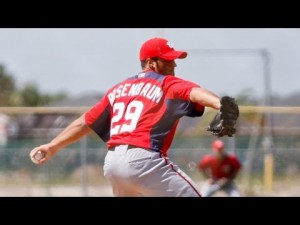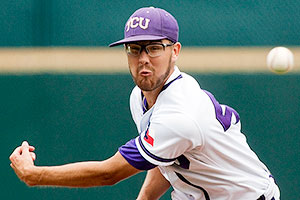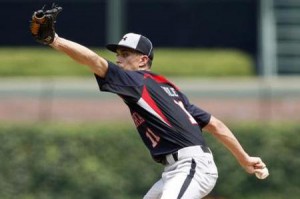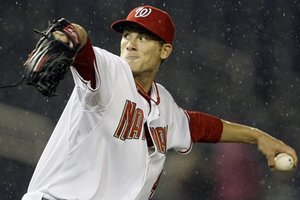-
Click here for the 2011 version of this post, for a look at how things were last year.
Here’s the AA version of the 2012 season pitching staff review. I’m going down the line from top to bottom; AAA is here. As with the other reviews, we’ll look at the main rotation, the substitute and spot starters, then focus on key relievers. Rehab appearances are not discussed.
Harrisburg starters. The rotation started the season with Gilliam, Demny, Mandel, Rosenbaum and Ballard. Lets see how the original rotation and other primary starters fared.
- Robert Gilliam, the “forgotten man” in the mega Gio Gonalez trade in December, made the opening day start for Harrisburg but didn’t live up to his billing. He got 13 starts before going to the bullpen, and then eventually getting demoted to Potomac. Season AA numbers: 3-7, 6.38 ERA. Outlook for next season: The team likes him as a starter; i’m guessing they give him another whirl in the AA rotation.
- Paul Demny took a step back in his progressive career with the Nats, going 6-8 with a 5.43 ERA in 23 starts before moving primarily to the bullpen at the end of the season. He’s still very young (just turned 23) but he’s finishing his 5th pro season and 2013 will be his “walk year.” Interestingly, the Nats named Demny one of their AFL participants, an odd selection based on his performance this season. Outlook for next season: as with Gilliam, I’d be surprised if Demny remains a starter. AA bullpen as a swingman unless the team needs a 5th starter.
- Jeff Mandel started the year in the Harrisburg rotation and put in 11 middling starts before getting moved to AAA to replace an equally ineffective Mitch Atkins. This marked the third straight season he had started in AA and moved to AAA, a sure sign of an organizational arm who filled in where needed. Outlook for next season: see AAA post.
- Danny Rosenbaum was supposed to be the Ace, the Star of this rotation. He was the highest-ranked prospect and was the Organization’s best starting pitching prospects. He didn’t really live up to his billing, going 8-10 with a 3.94 ERA and a 1.31 whip in 26 starts. He looked great his first 10 starts and then struggled the rest of the season. He turns 25 in the off-season and is Rule-5 Eligible. I think the team has to protect him. Outlook for next season: Added to 40-man roster ahead of the Rule-5 draft but back in AA to start 2013, with an eye on a mid-season promotion to AAA.
- Mike Ballard was a Minor League Free Agent signed from Baltimore (after failing to make it in the Houston organization after 5 minor league seasons). You would have thought he’d have been in AAA but started the season in the AA rotation. After 12 up-and-down starts he got absolutely pounded on June 13th, hit the DL with “elbow discomfort” and has been there ever since. Final season stats: 1-5, 4.31 ERA. Outlook for next season: released. You hate to cut a guy with a season-ending injury, but business is business.
- Ryan Perry, astutely acquired for Collin Balester (who failed to impress in Detroit and was DFA’d earlier this year) in spring training and he competed for the MLB bullpen. He featured briefly, was ineffective and was optioned to AAA. The team took a look at his repertoire and decided to try to convert him to a starter in AA. The results? Pretty good; a 2.84 ERA and 1.11 whip in 13 AA starts. Outlook for next season: here’s the problem with Perry; he’s out of options for 2013. He was added to a 40-man roster in April 2009, and burned options in 2009, 2011 and this year. So he has to either make the MLB club or be DFA’d at the end of spring training. So look for Perry to compete for the #5 starter job or be considered trade bait in the off-season.
- Kevin Pucetas is another Minor League Free Agent who probably was too experienced for AA (as with Ballard); he spent the previous 3 seasons in the Pacific Coast League. For Harrisburg in 2012 he was excellent out of the pen early (posting a 1.59 era in 34 relief innings) and then was relatively mediocre in 12 starts (5-5 with a 4.81 ERA). You have to think he was merely filler for a gap in pitcher development in this system and will be looking for work elsewhere for 2013. Outlook for next season: with another organization.
- Trevor Holder finally looked like he was putting things together early in Potomac, earned a mid-season promotion to Harrisburg and put up a 3.78 ERA in 10 starts (9 actual starts plus a 10th game where the “starter” went one inning on a rehab assignment). The knock on Holder was that he was a total signability pick in 2009 after the team spent big on Strasburg and Storen. It is good to see him putting some things together. Outlook for next season: AA rotation.
- Ryan Tatusko got 8 starts in 27 appearances in a long-man/spot-starter/swingman role for the team. He was slightly better as a reliever versus a starter (his splits showing a 2.72 ERA with greater than a k/inning as a reliever, a 4.50 ERA in his 8 starts). I have always liked Tatusko (not the least reason of which is that he writes a blog) and was eager to see him contributed after he came over (with Tanner Roark) in the Cristian Guzman trade. But his time with the organization may be at an end; he just finished his 6th minor league season and he took a step back with the organization. Outlook for next season: I thought he’d have been in AAA by now; perhaps 2013 is the year. AAA swingman.
- Other guys who got spot starts here and there (non-rehab):
- Brian Broderick: the team’s former rule-5 pick never made it with St. Louis, and when he was released the Nats picked him up. He got a handful of appearances down the stretch and finished the season with 3 starts. The team clearly likes the guy and seems willing to give him a chance. Outlook for next season: AAA rotation.
- Austin Bibens-Dirkx, he had a couple starts early before getting promoted up to AAA, where he probably should have started the season based on his experience. Outlook for next season: (as copied from the AAA post): with another organization.
- Adam Olbrychowski got called up to make the last start of the season. Outlook for next season: see High-A post.
- Of note: Chien-Ming Wang made no less than NINE rehab starts in AA (and fifteen overall minor league rehab starts). You can argue whether or not the organization was “bending” the DL/service time rules or not; either way I can’t see how Wang stays with this team for 2013 and beyond.
Harrisburg Relievers: taking a look at the relief corps at the end of the season. They used an awful lot of them.
- Marcos Frias finishes his 6th pro season taking a step back from his 2011 numbers in high-A. On the year, a 4.82 ERA in 65 1/3 relief innings. He’s still very young, being a DSL graduate and yet to turn 24. Technically he’s rule-5 eligible but its hard to see a team taking a flier on a RH reliever without knock-out stuff. Outlook for next season: back in AA bullpen.
- Erik Davis was generally excellent all season for Harrisburg, posting a 2.52 ERA in 64 1/3 relief innings. He earned a late season promotion to AAA. The former starter and trade bounty for Alberto Gonzalez technically is rule-5 eligible but the risk of losing him seems slight. Outlook for next season: AAA bullpen, looking to become the next Christian Garcia.
- Patrick McCoy had a pretty good season out of the pen in Harrisburg; 7-3 with a 3.70 era in 58 1/3 innings. He was rule-5 eligible in 2011 but didn’t get picked up. Now he’s one year from being a Minor League Free Agent. Outlook for next season: AA or perhaps AAA bullpen, whoever needs a left hander.
- Hector Nelo, who was released by Texas in April of 2011, finished the year with strong numbers as the team’s primary closer. He had a 2.73 era and 16 saves in 52 2/3s innings over 47 appearances. More importantly his K/9 rates really jumped from 2011. He’s the kind of big-time arm that Mike Rizzo loves (he can reportedly hit 100mph) and should get some looks going foward. He’s tied to the organization for one more season. Outlook for next season: the closer in AAA.
- Rafael Martin was as unbelievably bad statistically in 2012 as he was good in 2011. How do you go from a 1.65 ERA across 2 organizations in 2011 to a 6.69 ERA in 2012? Perhaps the answer is either a late-season injury or fatigue; in his last four appearances in AA this season he gave up 11 earned runs; the 6 appearances before that just one. He’s no spring chicken though; he’s already 28 and is far far too old for AA at this point. Outlook for next season: bullpen in AAA and hoping for a rebound to 2011’s numbers.
- Cameron Selik pitched 1/3 of an inning in AA before a season-ending injury. Outlook for next season: See High-A writeup.
- Pat Lehman got promoted to AAA. Joe Testa got demoted to High-A. See those write-ups for outlooks.
- Other Relievers who appeared in AA of note (not including Rehabbing MLBers): Outlook for next season for all of these guys seems the same: either continued “org guy” middle reliever or minor league FA in another organization.
- Zech Zinicola came back to the team after being rule-5 drafted in late 2009, and remains an organizational arm.
- Jimmy Barthmaier split time between AA and high-A. Org arm.
- Corey VanAllen was demoted down from AAA and then got hurt in July. Org arm, maybe a loogy in AA again.
Summary
Harrisburg struggled to find a good consistent group of starters. My guesses on what role these guys will play next season list too many guys getting dumped into the bullpen, so it may be interesting to see who gets another shot at starting in 2013. Unfortunately these injuries and inconsistencies cost the team a near-certain 2nd half playoff spot.




